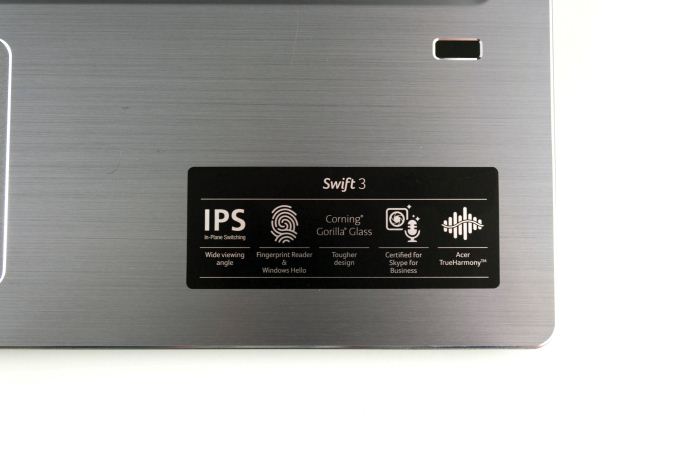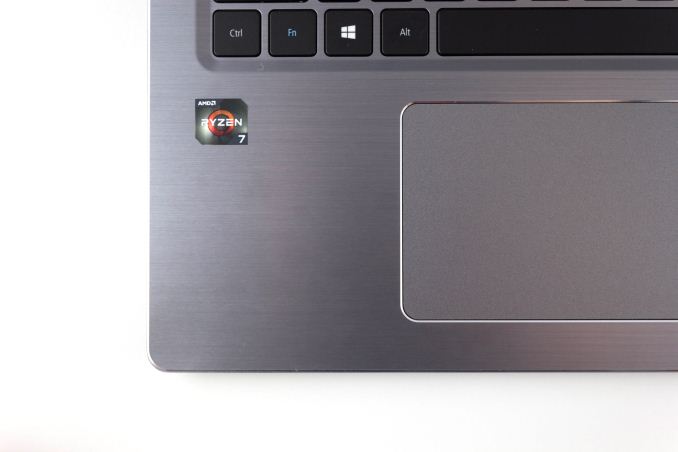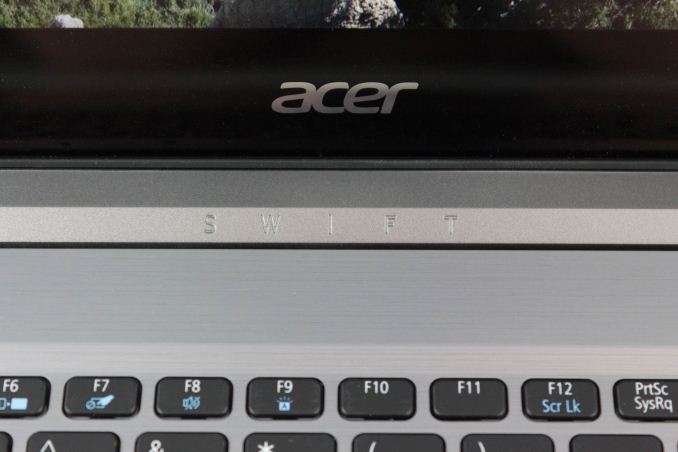The Acer Swift 3 SF315-41 Review: Ryzen Meets Laptop
by Brett Howse on May 3, 2018 8:00 AM EST- Posted in
- Laptops
- Acer
- AMD
- Ryzen
- Ryzen Mobile
- Raven Ridge
Final Words
This review is really looking at two things. First, the Acer Swift 3, and second, the AMD Raven Ridge platform based on Ryzen mobile. Let’s start with the laptop.
Acer’s Swift lineup features models from the Swift 1 at the value end, to the Swift 7 at the top end. So, the Swift 3 is closer to the value end than Acer’s flagship models. But that’s somewhat deceptive because Acer’s Swift 3 is a nicely built device, with a great aluminum exterior, an IPS display, SSD storage, and even a fingerprint reader alongside the excellent trackpad.
It’s not all sunshine and roses for the Swift 3 though. The keyboard is not only cramped with the number pad squeezed in on the right, but the keys themselves are also very poor, with a slippery texture that makes it very easy to miss the key you’re looking for. It does feature backlighting, but the backlighting turns off quickly, and using the trackpad doesn’t light up the keys like it does on most laptops.
The small battery also cuts into the maximum life when not plugged in, and that’s purely a cost decision because there’s plenty of room inside a notebook this big for more battery. Plus, the high baseline power draw pulls down the battery life as well. Compared to a couple of years ago, the battery life is still quite good, but it’s definitely not all day by any means.
The display has great grayscale and white levels, but doesn’t even come close to covering the entire sRGB spectrum, which is something that most laptops do now. At 1920x1080, it does offer enough resolution at least, and of course it’s IPS which is a requirement at this point.
AMD’s Raven Ridge platform has done very well though. The CPU performance is much stronger than the outgoing Carrizo notebook platform, although it’s not quite up to the latest Kaby Lake in terms of absolute performance. But the addition of a real GPU onto the SoC is a welcome change, and allows actual 3D gaming even on a 15-Watt processor. The performance of the Vega GPU is so much better than the Intel integrated solution that really adds a lot of capability.
The combination of AMD’s Ryzen mobile, along with a good design, and excellent specifications for the price, really do make the Acer Swift 3 an appealing proposition. We’ve never tested a laptop at this price point with a 512 GB SSD before, and the 8 GB of DDR4 is very welcome as well at this price. If you can get over the poor quality keyboard, there’s a lot of laptop for the dollar here, and the ability to actually run real games is a welcome change.













78 Comments
View All Comments
kaidenshi - Thursday, May 3, 2018 - link
640KB is enough for anyone.In all seriousness, this is a midrange laptop and 8GB is midrange these days. Unless you're trying to use it for containers/VMs, 8GB is plenty for the kind of use case a laptop like this will see.
Now, if they included the right GPU to make it a gaming laptop, I'd love to see it come with 16GB with the option of 32GB. But in this case, 8GB is plenty.
Targon - Tuesday, May 8, 2018 - link
That is the problem, a mid-range laptop is generally that $450-$650 range. Add the SSD and you go into the next price category. RAM being overpriced at this point is a part of the problem, but it isn't the only reason the cheapest you can find a Ryzen based laptop is $600 at this point.kfishy - Wednesday, May 9, 2018 - link
Unfortunately a side effect of Ryzen’s success is retailers can mark it up much more.Jimster480 - Monday, May 28, 2018 - link
There are $400 Ryzen 3 laptops, its just that if its a Ryzen 5+ then its double the cost.Jimster480 - Monday, May 28, 2018 - link
Its not when its a single channel 2133mhz ram setup...Its the cheapest ram, cheapest SSD, cheapest screen, cheapest battery.... all for a price more than an i7 + dedicated GPU with double the ram!
tn_techie - Thursday, May 3, 2018 - link
Regarding Cinebench and system tests, it's clear that premium built notebooks like Microsoft's surface products, or even the Asus Zenbooks, will have better results than the Swift 315, as the components quality and thermal solutions are way higher than the Swift's. Most plasticky midrange notebooks with Kaby Lake R chips score lower Cinebench results than the 2700U when coupled with a random nonchalant thermal solution from the likes of Acer, Asus or any of the major OEMs. The problem with Raven Ridge, is that it can't feature on higher end designs, due to the lack of LPDDR support, and therefore it won't benefit from the advantage of being on a truly premium system, with great cooling, a big battery, full cutting edge connectivity, best-in-class NVMes etc.. It's condemned, at best, to the high midrange tier, with tradeoffs and sacrifices here and there.Spunjji - Friday, May 4, 2018 - link
I'm pretty sure it's less the LPDDR support and more mindshare / marketing dollars that keep AMD out of the high-end products.tn_techie - Friday, May 4, 2018 - link
I think that the Ryzen brand has proved itself over the last 12 months. There's a lot of excitement around it, and its reputation is actually sky high. That's why I don't think it's the old mindshare issue, with people automatically recognizing AMD based products as low-end. However, consumers associate high-end CPUs with the premium notebook offerings. And as long as you're unable to showcase your products in the XPS, Spectre, Zenbook, Surface etc.. lineups, you won't be granted the full recognition you deserve. And the lack of LPDDR support is the main hurdle here.Try putting a 2700U in the chassis of an XPS 13 for example. Battery life will be disappointing, but performance would be outstanding.
Jimster480 - Monday, May 28, 2018 - link
The battery life of the XPS13 is very disappointing... especially since the Spectre and Meltdown bugs... I can barely get 4 hours out of my XPS13 just browsing in Firefox...Its basically a useless disaster of a laptop with poor performance for anything outside of web browsing.
Intel knows it and they will pay billions to keep the ryzen chips out of something like the XPS13.
LPDDR vs DDR4 really isn't a major factor when it comes to notebook battery life. It may sacrifice an hour or two but considering the actual tested battery life of basically every intel machine post these patches for the CPU bugs.... well I think the two would be on par with the Ryzen maybe even pulling ahead.
Jimster480 - Monday, May 28, 2018 - link
Exactly! There is no disadvantage to Ryzen that keeps it out of the premium sector other than that its made by AMD and Intel is throwing marketing dollars at companies to make sure AMD doesn't see the light of day.